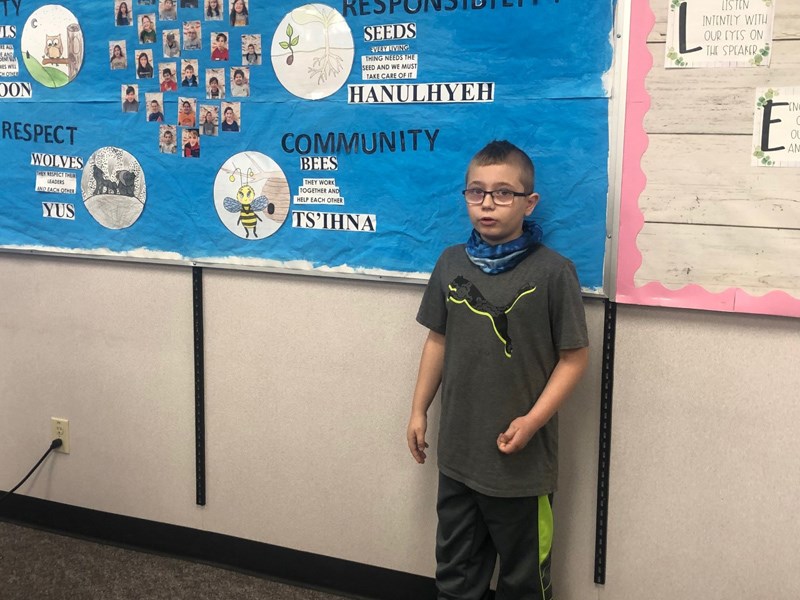Students in a grade four/five class at Ron Brent Elementary School are implementing Dakelh ways of knowing into their everyday learning.
Their teacher, Ashley Serai, who is new to Prince George, wanted to know more about local Indigenous knowledge and began a collaboration with Kelsey MacDonald, a resource teacher in the Indigenous education department.
MacDonald then explained the Dakelh Holistic Lifelong Learning Model which is focused on the concepts of Truth and Honesty, Responsibility, Respect, Self-Identity, and Community, and together with the students, they explored how they could bring this into the classroom.
“It embedded a culture of learning of inclusivity because every student had a voice in this,” said MacDonald.
“We did this as a class and a community and the fact that all of them are embedding these values of the Dakelh Ways of Knowing and enduring understanding into their everyday life is really beautiful.”
The students split up into three groups: researchers, artists, and helpers. They decided together which animals best represented each way of knowing and then together created a mural to display those concepts in their classroom.
“I researched the animals and figured out why they would fit best for community, respect, self-identity, responsibility or truth and honesty. I helped figure out why each one of those would fit for this project,” said grade 4/5 student, Titus.
The students picked bees to represent community, seeds for responsibility, beavers for truth and honesty, owls for self-identity and wolves for respect.
“I think bees fit community very well because they work together and help each other in the colonies as they do in the community.”
Titus said he thought the project was both challenging and fun and that he liked having the Ways of Knowing in the classroom.
“I think it helps us because if we are having trouble we can always turn to this and be like ‘this is our ways of knowing’ and we try to use this in our class and it's always better to try than to not try.”
Titus’ classmate Starlynn was one of the helpers who assembled the mural.
“I think this went pretty well because everyone is always trying to follow all of these rules on the Dakelh poster and they actually are starting to work and everyone is doing the things on this poster,” she noted.
“We had a lot of fun doing this writing, drawing, researching and painting the background.”
Sarai said, as their teacher, she can see how implementing the Dakelh Ways of Knowing has affected the students in their everyday lives.
“I see it in the classroom and I see it outside of the classroom, when they are out on the playground when they treat each other with so much respect, and make sure that they are okay. It’s wonderful,” said Sarai.
“It will change each year with each class, based on who the students are what they feel really resonates with them, but it is something that I will do forever when I am teaching in Prince George.”
The Dakelh Holistic Lifelong Learning Model was developed through School District No. 57 in collaboration with Elders a few years ago but was redeveloped this year as a tool for teachers to implement in their classrooms.
Jennifer Pighin, Indigenous education vice-principal for language and culture, said the concepts highlighted in the model are traditionally taught through land, experiential learning, protocols and, of course, language as worldview and perspective are embedded in language.
“We worked on developing a poster that was reflective of that,” said Pighin. “The biggest piece is that students are in the centre and they are surrounded by their parents, their Elders, and our family that is our community. These values are what drives how we learn in our world.”
She added she wants to honour and thank the Elders who knowledge informed the learning model.
“I think it is absolutely amazing to see this poster and how the Elders' knowledge has been brought forward and how they are activating it, living it and being a part of it,” said Pighin.
“I think that is really something that has been missing in education is that values-based approach and the knowledge from the Indigenous Elders.”
Sarai is the first teacher in the district to embed this holistic learning model into the classroom but MacDonald says other teachers in the district have been inspired by the project.
“Since Ashley did it, I think the Indigenous education department has six staff meetings that we are going to do to showcase this work,” said MacDonald.
“It brought tears to our eyes when we saw this go from a poster on the wall into practice and how Ashley is using it every day with her class and we are continuing to do work together throughout the year.”




